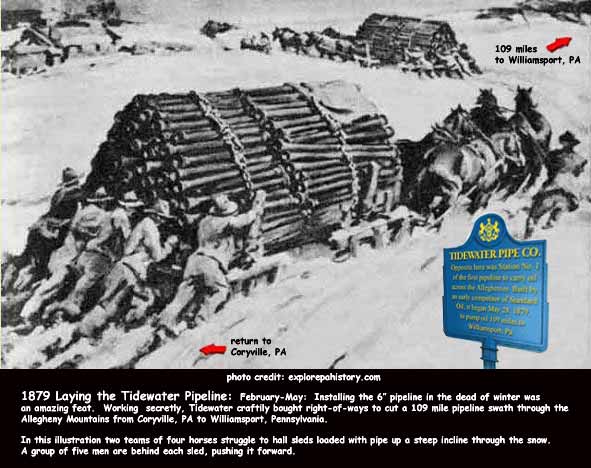Coryville, PA to Williamsport, PA - Backers Foil Standard Oil Monopoly

1879: Tidewater Pipe Company-World's 1st Successful Oil
Pipeline
Coryville, PA to Williamsport, PA - Backers Foil
Standard Oil Monopoly

Mckean County
Interests Defeat Powerful Standard Oil Monopoly- Coryville Makes History from Timeless Home ©2003 Smethport, PA, Ross Porter Editor Standard Oil Company, the tool of oil mogul John D. Rockefeller, had a monopoly for transporting oil over its extensive rail lines. To bypass his monopoly, the Tidewater Pipe Company was formed in 1878. The Tidewater Pipe Company changed the method in which oil was delivered. Oil previously was pumped in three-inch diameter pipes over relatively short distances and across level terrian. Tidewater, however, was the first to build over mountainous terrain. Working secretly, Tidewater craftily bought right-of-ways to cut a 109 mile pipeline swath to Williamsport, Pennsylvania. Six-inch pipe was laid on the ground surface in the dead of winter. As soon as the summer sun hit the exposed black pipe, it buckled and expanded but remarkably, the oil line never broke. Crews later buried the pipe under ground to prevent any further problems due to exposure of the pipe to the elements. The construction of the pipeline ranks as one of the all-time great achievements in the annals of oil exploration. On May 28 1879, the 80-horsepower pumps located in Coryville sent an oil flow of 250 barrels an hour across the mountains and ultimately into Williamsport on June 4th. A week later the Reading Railroad was formed, and oil deliveries by rail became common to the New York City area markets. The Tidewater Pipe Company sucessfully destroyed the Standard Oil Company's monopoly on oil transportation. Locally, the oil boom prompted the large tank farm in Coleville, and the Quaker State refinery in Farmers Valley. Probably the single largest industrial employer in the Smethport area, the refinery has since become Honeywell, and specializes in the extraction of wax from petroleum. The oil fields produced jobs for drillers, roustabouts, teamsters, pumpers, contractors and laborers. Supporting indutries like Bovaird and Seyfang, and Dresssers in Bradford, thrived as well. |
|
Birth of Coryville's Tidewater
Pipe Line
|
HISTORY-MAKING OIL FIELD
EVENT AT CORYVILLE CITED WORLD’S FIRST PIPELINE TRIED THERE 55 YEARS AGO McKean Democrat Volume 5 (rest unknown) Editor Russell R. Lindsley Smethport, Pa., Thursday, May 10, 1934 A full-page advertisement in the Saturday Evening Post this week dramatically revives a fact little known to the younger generation – that at Coryville, now a hamlet near Smethport, 55 years ago occurred an incident as important to the great world oil industry as Fulton’s first steamboat was to human transportation. It was the opening of the world’s first pipeline, regarded as a crazy experiment, built to carry oil, brought to Coryville from wells of the nearby Bradford field for storage in tanks underground and over the Allegheny mountains to Williamsport, Pa, 100 miles away. The scheme worked perfectly and from the first experiment launched with colorful ceremony at Coryville grew the pipeline method of conveying oil with thousands of miles of pipeline throughout the United States and in every country of the world where oil is produced. The Coryville-Williamsport line was eventually extended to the Atlantic seaboard in New Jersey. The Coryville pump station was soon followed by other pumping plants and pipelines at nearby Colegrove, Rixford, and other points in this area. The advertisement in the Saturday Evening Post, commemorating an event which revolutionized the oil business, was inserted by Veedol Motor Oil, a Tide Water Associated Product. Accompanied by a drawing of the gathering which witnessed the turning of the first gate of the line, with a more or less accurate artist’s conception of the hills overlooking Coryville, the ad was captioned, “GAMBLERS LOST THEIR SHIRTS WHEN ‘BENSON’S FOLLY’ WORKED.” The text of the ad reads: “On the morning of May 28, 1879, the townsfolk of Coryville, Pa., were in a gay and carnival mood. Byron D. Benson was about to reveal his long promised miracle. A magic pipeline that would whisk petroleum over the mountains to Williamsport-over 100 miles away. “For months, ‘Benson’s pipe dream’ had been the talk of the town. Oil men called it a harebrained scheme. Gamblers bet 50 to 1 that no pump could be built powerful enough to force a stream of oil across the Alleghenies. “But Benson and his associates, the founders of the Tide Water Oil Company, had grimly proceeded with their project. They knew they had to win. They knew that the railroads were crushing the Pennsylvania oil producers to death with exorbitant freight rates. They knew that unless a cheaper way could be found for shipping Pennsylvania crude, the public would be forced to buy an inferior petroleum. “A great crowd was on hand when Benson turned the valve which let the first oil into the pipes. Came a clinking, thumping noise…and a mighty cheer arose. The oil was on its way, moving on and upward over the hills of Coryville. “Seven days later, the liquid gold poured out of the pipe terminals at Williamsport. And Tide Water knew it had completed the first leg of its pipeline journey to the sea.” |